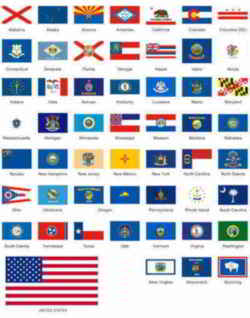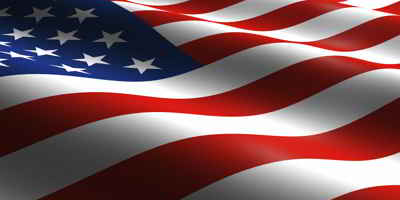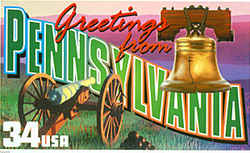Pennsylvania
State Flag
Adopted on June 13, 1907.
The first Pennsylvania State Flag to display the Pennsylvania Coat of Arms was authorized by the General Assembly in 1799. The state Coat of Arms was embroidered on a blue field on both sides of the flag.
On June 13, 1907, the General Assembly authorized the official Pennsylvania State Flag, a banner fringed in gold with the Coat of Arms embroidered on a field of blue. During the Civil War, some Pennsylvania regiments carried battle flags modeled after the American flag, but with the Coat of Arms in place of the block of stars in the corner. This kind of creative license was discouraged in 1907 when the General Assembly acted to standardize the State Flag.
The Pennsylvania State Flag
Pennsylvania's State Flag is composed of a blue field on which is embroidered the State Coat of Arms. The flag is flown from all state buildings, and further display on any public building within the Commonwealth is provided for by law.
The first State Flag bearing the State Coat of Arms was authorized by the General Assembly in 1799. During the Civil War, many Pennsylvania regiments carried flags modeled after the US Flag, but substituted Pennsylvania's Coat of Arms for the field of stars. On June 13, 1907, the Pennsylvania General Assembly standardized the design of the flag and required that the field of blue be the same color as the blue of the Flag of the United States. The law requires that the flag
"...shall be of blue, the same color as the blue field in the flag of the United States, and of the following dimensions and design; to wit, The length, or height, of the staff to be nine feet, including brass spear-head and ferrule, the fly of the said flag to be six feet and two inches, and to be four feet and six inches on the staff; in the center of the flag there shall be embroidered in silk the same on both sides of the flag the coat of arms of the Commonwealth of Pennsylvania, in proportionate size; the edge to be trimmed with knotted fringe of yellow silk, two and one-half inches wide; a cord, with tassels, to be attached to the staff at the spear-head, to be eight feet and six inches long, and composed of white and blue strands."
Pennsylvania's Coat of Arms
 Pennsylvania's
Coat of Arms, while not used in the same official capacity as the State Seal (although it contains
the emblems of the seal), is perhaps a more familiar symbol of the Commonwealth of Pennsylvania.
It appears on countless documents, letterheads, and publications, and forms the design on Pennsylvania's
State Flag. Provincial Pennsylvania's coat of arms was that of the Penn family. A state
coat of arms first appeared on state paper money issued in 1777. This first coat of arms was
nearly identical to the State Seal, without the inscription. In 1778, Caleb Lownes of Philadelphia
prepared a coat of arms. Heraldic in design, it consisted of: a shield, which displayed the
emblems of the State Seal --- the ship, plough, and sheaves of wheat; an eagle for the crest;
two black horses as supporters; and the motto "Virtue, Liberty and Independence."
An olive branch and a cornstalk were crossed below the shield. Behind each horse was a stalk
of corn, but these were omitted after 1805.
Pennsylvania's
Coat of Arms, while not used in the same official capacity as the State Seal (although it contains
the emblems of the seal), is perhaps a more familiar symbol of the Commonwealth of Pennsylvania.
It appears on countless documents, letterheads, and publications, and forms the design on Pennsylvania's
State Flag. Provincial Pennsylvania's coat of arms was that of the Penn family. A state
coat of arms first appeared on state paper money issued in 1777. This first coat of arms was
nearly identical to the State Seal, without the inscription. In 1778, Caleb Lownes of Philadelphia
prepared a coat of arms. Heraldic in design, it consisted of: a shield, which displayed the
emblems of the State Seal --- the ship, plough, and sheaves of wheat; an eagle for the crest;
two black horses as supporters; and the motto "Virtue, Liberty and Independence."
An olive branch and a cornstalk were crossed below the shield. Behind each horse was a stalk
of corn, but these were omitted after 1805.
Numerous modifications were made to this coat of arms between 1778 and 1873, chiefly in the position and color of the supporting horses. In 1874, the legislature noted these variations and the lack of uniformity and appointed a commission to establish an official coat of arms for the Commonwealth. In 1875, the commission reported that it had adopted, almost unchanged, the coat of arms originally designed by Caleb Lownes ninety-six years earlier.
The coat of arms of Pennsylvania is an official emblem of the state, alongside the seal
and state flag, and was adopted in 1778. The flag of the Commonwealth of Pennsylvania consists
of a blue field on which the state coat of arms is embroidered. The Pennsylvania coat of arms
features a shield crested by an American bald eagle, flanked by horses, and adorned with symbols
of Pennsylvania's strengths- a ship carrying state commerce to all parts of the world;
a clay-red plough, a symbol of the Pennsylvania's rich natural resources; and three golden
sheaves of wheat, representing fertile fields and Pennsylvania's wealth of human thought and
action. An olive branch and cornstalk cross limbs beneath- symbols of peace and prosperity.
The state motto, "Virtue Liberty and Independence", appears festooned below.
The coat of arms is surrounded by draft horses on both sides, and a bald eagle, which represents
Pennsylvania's loyalty to the United States, above. The state coat of arms includes a ship
under full sail, a plow, and three sheaves of wheat indicating the significance of commerce,
labor, perseverance, and agriculture to the state. Surrounding the coat of arms are a stalk
of Indian corn on the left and an olive branch on the right. These represent the state's recognition
of its past and its hope for the future. The scroll below the coat of arms reads, "Virtue,
Liberty and Independence", which is the state's motto

The Flags of the US.







